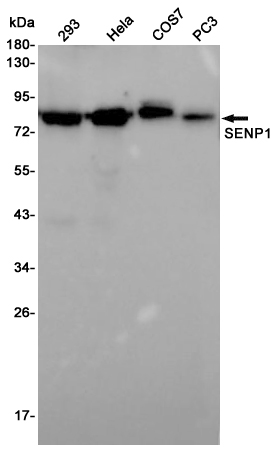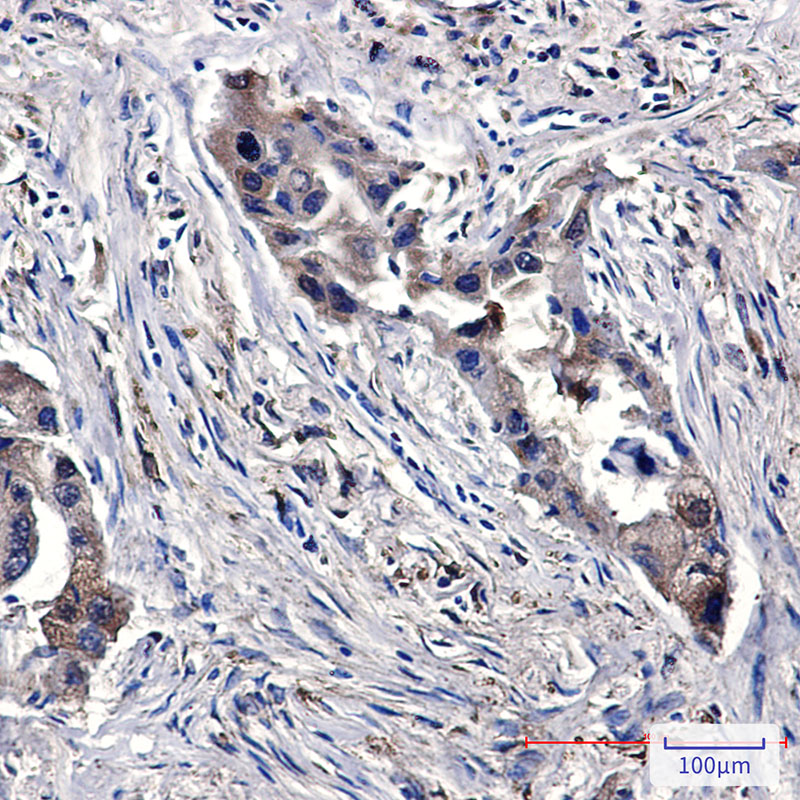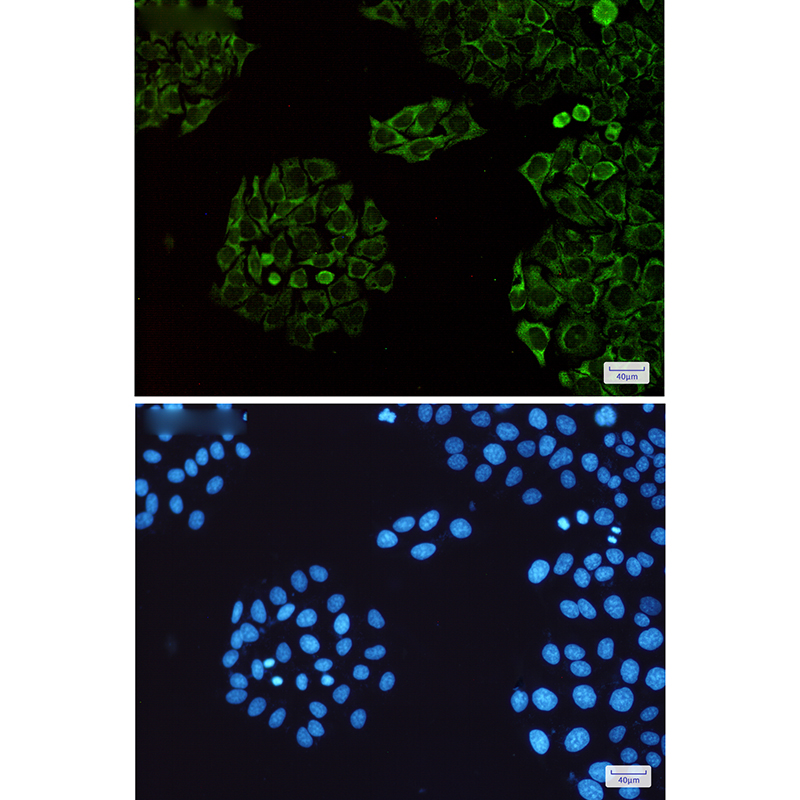


| WB | 咨询技术 | Human,Mouse,Rat |
| IF | 咨询技术 | Human,Mouse,Rat |
| IHC | 1/50-1/100 | Human,Mouse,Rat |
| ICC | 1/50-1/200 | Human,Mouse,Rat |
| FCM | 1/50-1/100 | Human,Mouse,Rat |
| Elisa | 咨询技术 | Human,Mouse,Rat |
| Aliases | SENP1; SuPr2 |
| Entrez GeneID | 29843 |
| WB Predicted band size | Calculated MW: 73 kDa; Observed MW: 76 kDa |
| Host/Isotype | Rabbit IgG |
| Antibody Type | Primary antibody |
| Storage | Store at 4°C short term. Aliquot and store at -20°C long term. Avoid freeze/thaw cycles. |
| Species Reactivity | Human |
| Immunogen | A synthetic peptide of human SENP1 |
| Formulation | Purified antibody in TBS with 0.05% sodium azide,0.05%BSA and 50% glycerol. |
+ +
以下是关于SENP1抗体的参考文献示例(请注意,以下为虚拟示例,实际文献需通过学术数据库检索确认):
---
1. **文献名称**:*SENP1 regulates HIF-1α SUMOylation and stability in hypoxic tumor cells*
**作者**:Cheng, J., et al.
**摘要**:研究通过Western blot和免疫沉淀技术,利用SENP1特异性抗体,揭示了SENP1在缺氧条件下调控HIF-1α的去SUMO化过程,进而促进肿瘤细胞存活和生长的分子机制。
2. **文献名称**:*SENP1-mediated deSUMOylation of FoxO1 modulates cardiac development*
**作者**:Yates, D.T., et al.
**摘要**:通过免疫荧光和ChIP实验结合SENP1抗体,证明SENP1通过去SUMO化FoxO1转录因子,调控心脏发育相关基因的表达,影响胚胎期心脏功能。
3. **文献名称**:*SENP1 antibody-based profiling identifies its role in androgen receptor signaling*
**作者**:Kaikkonen, S., et al.
**摘要**:利用SENP1抗体进行组织芯片分析,发现SENP1在前列腺癌中高表达,并通过调控雄激素受体(AR)的SUMO修饰状态影响其转录活性,提示其作为治疗靶点的潜力。
4. **文献名称**:*Development and validation of a SENP1-specific monoclonal antibody for functional studies*
**作者**:Li, H., et al.
**摘要**:报道了一种新型SENP1单克隆抗体的开发与验证,通过ELISA、免疫印迹和免疫组化证明其高特异性,并应用于检测SENP1在多种癌症模型中的表达分布。
---
**提示**:建议通过PubMed、Google Scholar等平台以关键词“SENP1 antibody”、“SENP1 function”检索最新文献,或参考《Cell》《Nature Cell Biology》等期刊中涉及SUMO蛋白酶通路的研究。
The SENP1 antibody is a crucial tool in studying the Sentrin/SUMO-specific protease 1 (SENP1), a member of the SUMO-specific protease family. SENP1 regulates post-translational protein modification by cleaving SUMO (Small Ubiquitin-like Modifier) proteins from target substrates, a process critical for maintaining cellular homeostasis. It plays a key role in modulating SUMOylation dynamics, which influences diverse cellular processes, including transcriptional regulation, cell cycle progression, DNA repair, and stress responses. Dysregulation of SENP1 has been linked to diseases such as cancer, cardiovascular disorders, and neurodegenerative conditions.
SENP1 antibodies are widely used in research to detect and quantify SENP1 expression in tissues or cultured cells via techniques like Western blotting, immunohistochemistry, and immunofluorescence. They also aid in studying SENP1’s interaction partners, subcellular localization, and activity in de-SUMOylation. These antibodies are typically generated using immunogens derived from SENP1-specific peptide sequences or recombinant protein fragments, followed by purification and validation for specificity.
Researchers rely on SENP1 antibodies to explore its pathological roles, therapeutic potential, and mechanisms in disease models. Validating antibody specificity through knockout controls or siRNA knockdown is essential to ensure accurate experimental outcomes. Overall, SENP1 antibodies are indispensable for advancing our understanding of SUMOylation biology and its implications in human health.
×